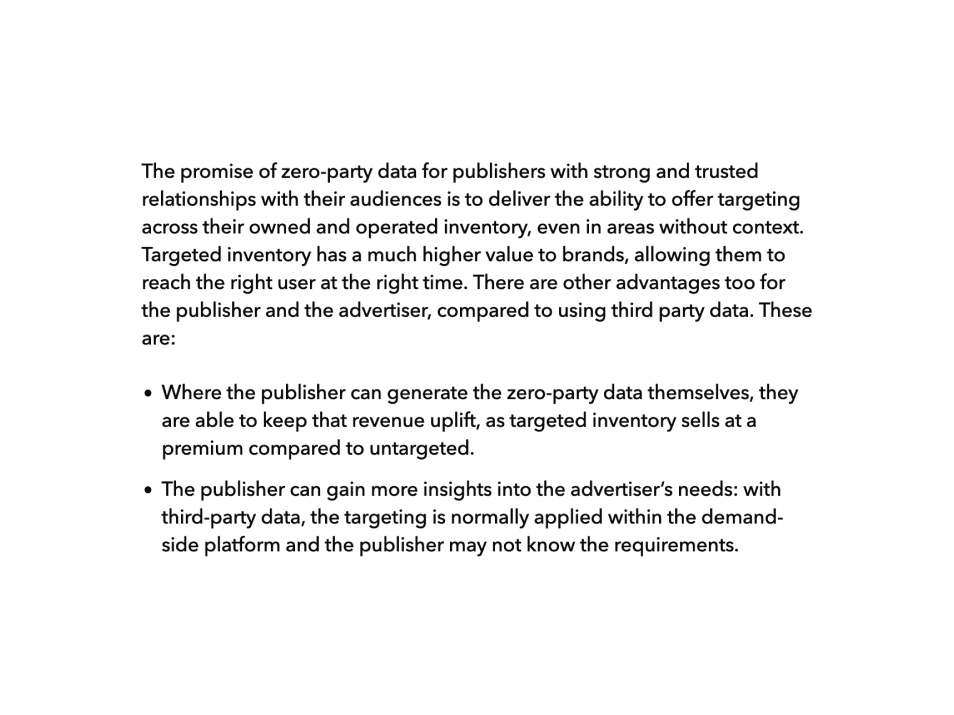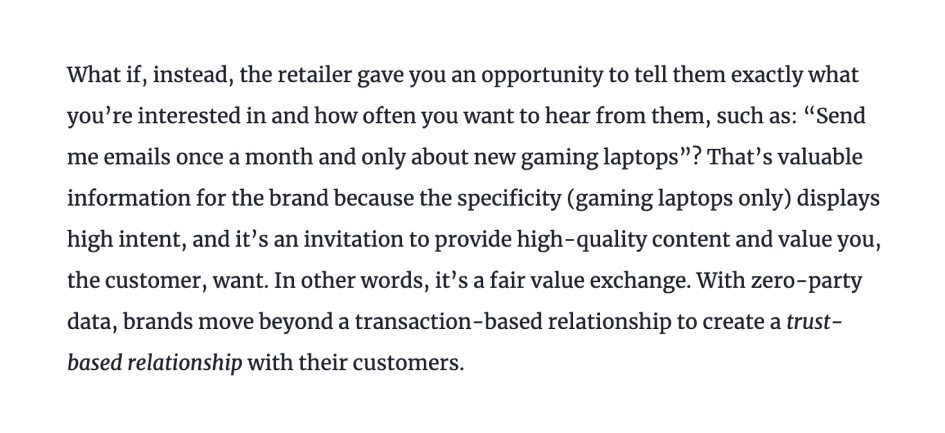Opinions and Expertise
Zeroing in on zero-party data: What marketers are saying
With the end of the era of cookies effectively coming to a close at the end of 2024, harnessing the importance of zero-party data has never been of higher importance. We put our ears to the ground to hear what marketers are actually saying about zero-party data, ongoing themes in the industry, and what this all means for you.

Marketers currently find themselves between the ultimate rock-and-hard-place of consumer demands. As Jack Paxton so eloquently states:
“In a very real sense, we marketers are slowly being backed into a corner. On the one hand, customers demand personalization at every step of their buyer journey. And on the other hand, they’re increasingly suspicious about how their data is collected and used.”
We know the death of cookies is approaching, and it’s sure to drastically change data collection practices.
Despite imminent change, most of us will go on without changing anything. (Kind of like ignoring a certain streaming service’s threats to end password sharing as we keep binging Stranger Things on a friend’s sister’s account.)
Netflix aside, marketers can’t afford to “chill” on the data collection front. Google will effectively end the era of third-party cookies in 2024—meaning it’s time for marketers to embrace zero-party data.
So what does the future of marketing look like? In short, a balancing act between highly-personalized digital experiences and necessary data privacy.
To do that, marketers need to become intimately familiar with all-things zero-party data.
What top marketers have to say about zero-party data
If you’re motivated to learn about how to apply zero-party data practices in the real world, you probably already know the basics. (If you need a primer, we’ve got you covered.)
We think the best way to learn what’s top of mind in the marketing sphere is to listen to what marketers are actually saying about zero-party data.
Let’s break down the three key emerging themes and what they mean for you.
1. Zero-party data is better for marketers and buyers.
Zero-party data has moved from being a nice-to-have to an essential part of any brand’s marketing strategy. Just as GDPR redefined data privacy norms back in 2018, marketers once again need to make major changes when it comes to engaging an audience.
In fact, the loss of third-party cookies is just one piece of the customer-dissatisfaction puzzle. As Sergio Maldonado describes, it’s likely to lead to a total marketing revolution.
This “perfect storm” forces marketers to stop relying on third-party data and adopt not only new data collection practices but a whole new mindset—one that solely focuses on the customer.
This monumental transition brings some major growing pains along with it. As Brett McGrath explains, marketers are essentially undergoing a data detox—and the third-party-cookie withdrawal is real.
Here’s the good news. Zero-party data isn’t just better for your customers—and their growing concerns for privacy and data usage. It’s better for brands, too.
Remember the modern marketing paradox we mentioned? Customers demand personalization, and they want data privacy—even though their data is what provides said personalization. Zero-party data offers an answer to this dilemma.
It gives you the best of both worlds by letting you capture customers’ thoughts, preferences, and sentiments—directly from those customers. In turn, transparency builds trust, as we see in Jack’s summary of zero-party data benefits.
In addition to accuracy, trust, and exclusivity, zero-party data also offers advantages to content publishers and the advertisers that rely on them for targeted reach. Here’s how Cadi Jones explains those benefits:
While zero-party data offers clear wins for all involved, there’s definitely a wrong way to approach collecting it.
Christian Jones points out that many brands try tackling zero-party data with underwhelming customer loyalty programs. These typically offer low-value coupons or meaningless electronic swag that customers don’t care about. On top of that, brands then use collected data to spam customers with irrelevant content.
Christian advocates for approaching zero-party data through the lens of a “fair value exchange” where everyone wins:
Data collection that’s good for buyers is good for brands because it shows customers they can trust you.
To that end, Brett doesn’t just think of swapping third-party cookies for zero-party data as a shift in marketing tactics. He calls for a complete culture shift in favor of consent.
In the past, marketers have taken a collective “better to ask for forgiveness than permission” stance on data collection with their customers. (Just look at the fact that, until recently, iPhone users had to opt out of having their activity tracked—whereas they now have to opt in.)
But if sneaking out of the house during our teenage years has taught us anything, it’s that this attitude doesn’t build trust—with our parents then or with our audience now.
When customers assume that brands use and abuse their data, it keeps them on the defensive. But moving toward consent by focusing on zero-party data can turn the marketing tide and build new inroads with customers.
Matt Kleinschmit doesn’t sugarcoat things—there isn’t a ‘quick fix’ here.
But a healthier give and take of data where collection happens openly—even though it means doing things “the hard way” for marketers—will deepen customer relationships and help brands win the long game. That’s a better outcome for all involved.
2. Zero-party data collection needs to be part of your entire workflow.
Any major change like the ones marketers face now is difficult. Who wants to adjust all of their processes, let alone transform the way they market altogether?
Losing the traditional ways we’ve collected data means rebuilding many strategies from the ground up. The best way to approach this marketing change is to rethink how you collect data and begin gathering data firsthand throughout your workflow.
The great news is that you can use numerous customer touchpoints to learn more about your audience. While none of them may exude the homey comfort of the third-party-cookie ways we’ve known and loved, they can provide a pretty complete picture of your audience.
Take, for example, Eric Stockton’s list of potential data sources.
As you can see here, you have plenty of opportunities to understand your audience on hand.
In fact, plenty of those engagement points are interactions your customers already have with you. The actual data gathering lies in reviewing sales calls, support chats, or social callouts.
Other touchpoints, like self-reported data and survey responses, request data directly from customers, who offer their zero-party data voluntarily.
Yes, these ways of collecting customer data require relationship-building and a different kind of outreach. But game-changing customer insights can come from anywhere, so it makes sense to collect, review, and act on data from everywhere.
Collecting zero-party data at every touchpoint lets you more effectively act on not just the insights you’ve gathered directly from your customers, but customer insights from elsewhere in the industry.
Take this example from Klaviyo’s Tracey Wallace, who shared the marketing automation software’s consumer research report. Check out her top tip for using the data:
Savvy marketers know how to merge consumer insights with their own zero-party data gathered from individuals. That dynamic duo helps them market in ways that match how their unique audience behaves.
When you learn about your customers straight from the source and use that data to personalize their experience at every channel—from email to SMS—you build greater trust with them.
As you strengthen your relationships with customers, they’ll be less hesitant to share more zero-party data with you in the future. This is the strength of the incoming consent-based marketing culture.
Take this Klaviyo customer example that Tracey shared from a skincare brand that found this exact virtuous cycle in gathering and using zero-party data.
When you use surveys or quizzes to collect zero-party data, you gain the tools to further personalize your marketing through every channel. From there, you can tell better stories and make customers not only feel heard but want to be heard, so they’ll provide you with that data themselves.
3. Marketers who don’t adjust now will be caught flatfooted.
In the coming months, as the last vestiges of data collection’s “old guard” fade away, plenty of marketers will fall prey to the tempting voice of procrastination. This is a mistake.
What happens if you don’t start collecting zero-party data now? You’ll miss your chance to get a leg up on the competition and get ahead of the curve—or, at least, on track. Here’s how Eric explains it.
Waiting until the last minute to build a zero-party data strategy, or looking for the next most convenient approach, just won’t fit the bill.
Why? Because those tactics will mean you’re not embracing the new age of consent and consumer focus. And your customers will sniff that out from a mile away.
Make it a point to thrive, rather than just survive, by jumping headfirst into zero-party data.
This will mean using tried-and-true approaches to surveys and quizzes as well as finding creative new angles on familiar territory—but it all goes back to your customers and their needs.
Here, Matt recommends gathering key information using a convenient method that the customer prefers. This is what “the current sea change” is all about.
If you could use zero-party data to better understand your customers’ preferences, decision-making, and behaviors—on their terms—why wouldn’t you?
As the marketplace grows more competitive and buyers get more choosy, you’ll be spoon-feeding the advantage to your competitors if you’re not proactively changing your approach to customer data.
Start now, or risk the competition leaving you in the customer-data dust.
Take action: 6 ways to collect zero-party data
Now that we’ve looked at the big picture of how you should approach zero-party data, we’ll leave you with some practical and tactical ways that you can start collecting data right now.
- Use 1:1 mobile messaging to send surveys. From SMS to WhatsApp, use your audience’s favorite messaging channel for quick, convenient data collection. Let them know that the answers they provide will improve their experience—then deliver on that promise.
- Power personalization via email. Gather zero-party data through delightful surveys—like Typeform’s people-friendly forms—sent right to customers’ inboxes. Then use their answers to customize their journey even further. Ben Dutter says it’s a solid place to start your data-collection efforts.
- Poll your customers on social. Offer something they’ll actually want—like an exclusive product, unique experience, or meaningful discount—in exchange for their email and insights.
- Host and attend events. Whether you hold an event or show up as a vendor, events are a great chance to gather data directly from your audience, as Julius Solaris recommends to B2B marketers. Just make sure to use every touchpoint to offer real value in exchange.
- Tap into in-moment surveys. Gather zero-party data during the shopping experience in real time so customers know you’re there to make the experience even better.
- Help shoppers decide with personalized quizzes. Some shoppers already know what they want. But those who don’t will be more likely to buy when you show them the way. Dazzle them with quiz results just for them—plus, you’ll get valuable insights firsthand.
Whatever is next in the realm of data-driven marketing, zero-party data is the way forward.
When gathering data directly from your customers…there are zero downsides.















.png)
.png)